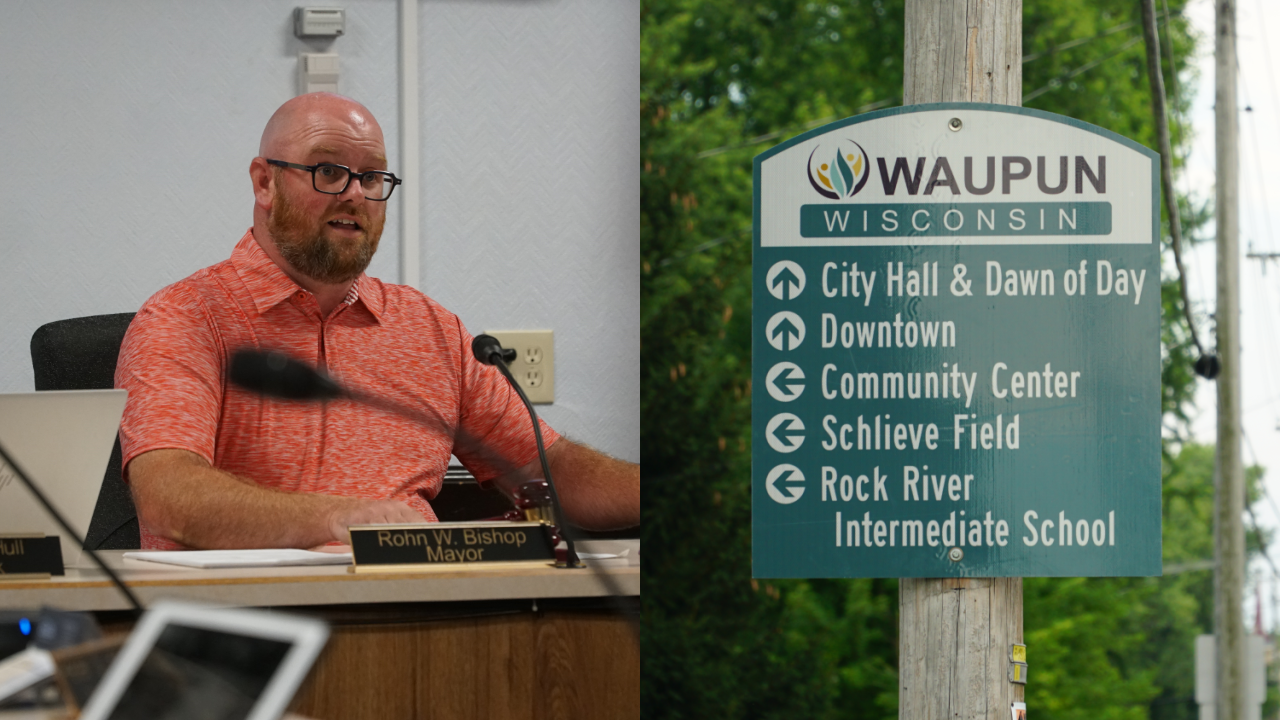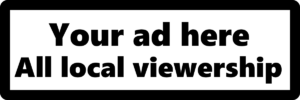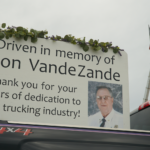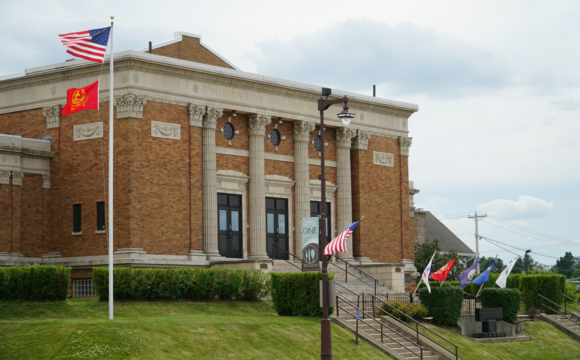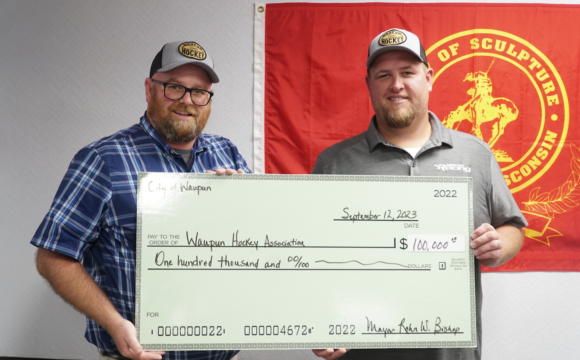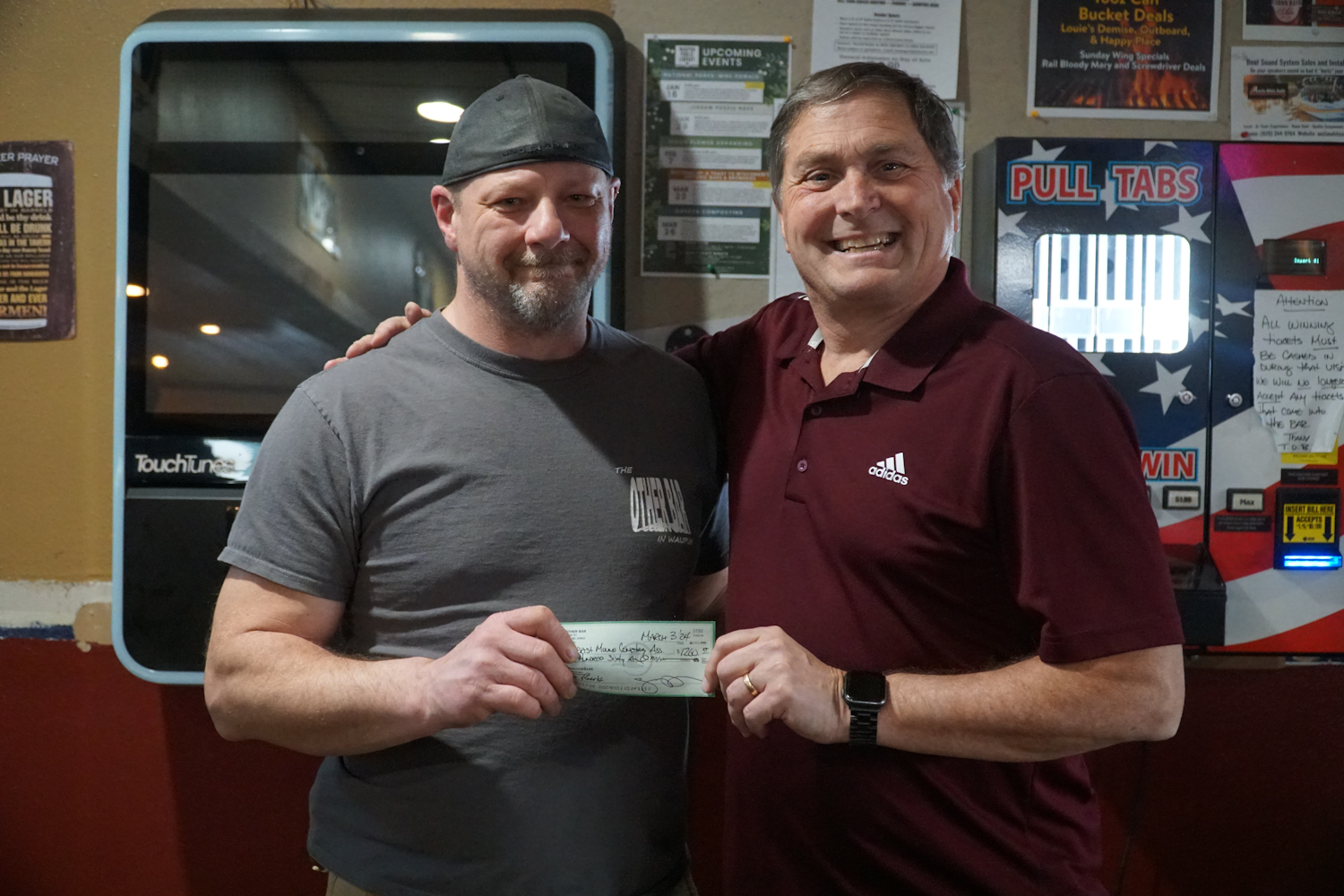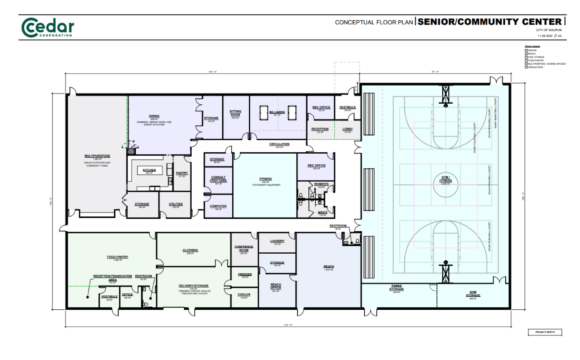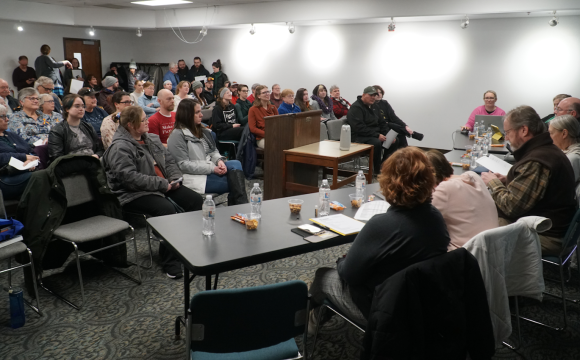WAUPUN — After hearing remarks from 18 local residents, the Waupun Common Council voted to purchase wayfinding sign decals depicting the various Waupun sculptures intended to cover up the current municipal logo on the signs put up earlier this month. In addition to the End of the Trail, the decals will likely include silhouettes of local statues “The Pioneers,” “He Who Sows Believes in God,” and “Dawn of Day,” also known as “Waubun,” the original Ojibwe word behind Waupun’s name.
Below is a full transcription of the public remarks given to the Common Council on August 8th, 2022.
Mayor Rohn Bishop: Slams gavel “I will call the August Waupun Common Council meeting to order. We will do the Pledge of Allegiance followed by a brief moment of silence.”
All: “I pledge allegiance to the Flag of the United States of America, and to the Republic for which it stands, one Nation under God, indivisible, with liberty and justice for all.” Moment of silence
Mayor Bishop: “Roll call, Angie.”
City Clerk Angie Hull: “Westphal.”
Alderman Jason Westphal: “Here.”
Clerk Hull: “Kaczmarski.”
Alderman Pete Kaczmarski: “Here.”
Clerk Hull: “Langford.”
Alderman William Langford: “Here.”
Clerk Hull: “Matoushek.”
Alderman Michael Matoushek: “Here.”
Clerk Hull: “Siebers.”
Alderman Daniel Siebers: “Here.”
Clerk Hull: “Vanderkin.”
Alderwoman Nancy Vanderkin: “Here.”
Mayor Bishop: “Alright! Persons wishing to address the Council. We try to keep it to two minutes; please state your name and your address and the subject of your comments. Who would like to go first?”
Barbara Schwark: “I’ll go.”
Mayor Bishop: “Cool beans.”
Barbara Schwark: “I just say my name and address then?”
Mayor Bishop: “State your name and address when you get up here, yes.”
Barbara Schwark: “My name is Barbara Schwark and I live at 120 Gateway. And I would like to make a comment about the End of the Trail. I feel that it is rich in history and I have always come to Waupun and it’s probably the first thing I’ve ever noticed is the sculptures. They’re beautiful. I looked at Shaler, what he was thinking and I also see that Fraser, being the artist that he was, did a beautiful job and I feel that the City of Sculptures and the End of the Trail should stay as it is. Thank you.”
Mayor Bishop: “Thank you. Next?”
Jay Graff stands
Mayor Bishop: “Jay! I would like to remind people: two minutes—Jay Graff.”
Audience laughs
Mayor Bishop: “I’ve seen you talk.”
Jay Graff: “Jay Graff, 18 Taylor St. I’m going to try to keep this very short—to two minutes. In a very smart way—for smart business development you always leverage your greatest assets to overcome any weaknesses or shortcomings that you have. The End of the Trail is a representation of the fine collection of sculptures we have and is so critically important to be included in branding all your marketing efforts. If you want to bring greater velocity of money into the community you have to bring people to the community with money. And cultural tourists spend $200 more than a conventional tourist will spend. I’d like you to take these things into consideration when you move forward with business this evening. But I’m very much in favor of including it in our branding and replacing the iconic ‘corn people’ logo. Thank you.”
Mayor Bishop: “Thank you Jay, you had like thirty seconds to spare.” Audience laughs “Alright, who would like to go next?”
Jason Whitford: “I’d like to go next.”
Mayor Bishop: “Sure.”
Jason Whitford: “Jason Whitford, 201 Brandon St.”
Mayor Bishop interjects: “Nice shirt.”
Jason Whitford: “Thank you. I came here for the last meeting; I’m glad to see there’s a bigger crowd. So yeah I was here last time and spoke in favor of the End of the Trail being on the signs. And I want to thank you Mayor Bishop for your leadership because in my opinion at the last meeting I didn’t see any leadership except for Mayor Bishop. Being an alderperson, you’re there to make decisions, so I think what needs to happen is you need to step up and make a decision. And I’m trying to be respectful here but the last thing I want to hear is ‘well if this goes in favor then I’m going to make a motion to reconsider.’ If you feel strongly about something, all of you, put it out on the table, that’s why we elect you. That’s, you know, that’s why this guy [Mayor Bishop] ran so I’m not sure what everyone is afraid of. So that’s all I have to say, thank you.”
Mayor Bishop: “Thank you. I like that we’re staying well below the two minute thing. Who would like to go next?”
Linda Burmania: “Yes, I’ll go next.”
Mayor Bishop: “Cool.”
Linda Burmania: “Linda Burmania, 620 Cochran St. I guess first of all I want to say that on social media there’s always this question of why did nobody else come forward in 2018 with this ‘branding’ thing being done. I think at that time it was not put out there to the public exactly what this ‘branding’ was for Waupun. And if you look at our city and what these statues, these sculptures—what you want to call them—have done for this community, the branding that is out there right now, what is that telling people outside of our state, even within our state, why they should come to Waupun, be a tourist, see what we have, spend money here? What do we have here in this town other than the statues and the Horicon Marsh? Yes we have agriculture, we have all that, but see a cornfield isn’t going to bring somebody here. So I think this whole ‘well why didn’t anyone come forward,’ because it wasn’t put out there exactly what was happening at that time and that’s really sad that that occured and I guess I’m in favor of keeping the statues and if someone is afraid of being sued because of these statues then you take that up when that occurs. But to offset the chance of that happening is when you put out better signage by the statues or with what the city is representing and what these statues actually mean and what they represent. We are not being negative with the statues or sculptures, we are actually honoring them and the Native Americans and what they went through. And let’s not erase history, it’s there. And the youth of this community and the youth after them, they need to learn. And as adults I would really hope we don’t take that away from them.”
Mayor Bishop: “Thank you.”
Audience applauds
Mayor Bishop: “And next. Dave.” David Hopp steps to podium “Thank you for your patience last week during the road construction project.”
David Hopp: Laughs “Dave Hopp, 107 Rock River Avenue. A little history, in 1964 Waupun celebrated the 125 anniversary of the city, and at that time the National Bank—and I believe it was the Leader News—sponsored Chief John Big Tree, who was the model for the statue, to come [to Waupun]. And I still have the brochure, and I was fortunate enough to meet the Chief and shake his hand—I was only 16 years old at the time. But he wasn’t offended by that, he was like, remember what we said, he was honored to be the pattern for that sculpture. He was also the model for the Buffalo Nickel. There were two other Indians as well and they made a combination of the three faces for that nickel. But obviously I’m in favor of the statue and so I hope we can keep it. Thank you.”
Mayor Bishop: “Thank you. Who would like to go next?”
Jim Levey steps towards podium
Mayor Bishop: “Mister Le—oh I’m sorry, Jim. If I call him Mister Levey he’ll come up here and hit me with his cane.”
Audience laughs
Jim Levey: “Jim Levey, I’m 419 West Spring Street. During the EAA I was out in the cemetery watering plants—Forest Mound—and a car pulled in and they pulled up to the Recording Angel—from Arkansas. I went ‘wow’; I asked them what brought them here and they said they came to Waupun to eat at one of our establishments and they picked up a brochure of the city, and I went ‘really’. And with that another one was pulling down around, a car from Illinois was taking pictures of the End of the Trail. And you know what, they weren’t taking pictures of the corn field or a wheat field or anything like that, it’s all the way around us. They came up through it, the statue is what brought them. And I’m hoping we can definitely keep this. It’s important. Thank you.”
Mayor Bishop: “Thank you, Jim. Who will go next? Mister Medema.”
Ken Medema: “Ken Medema, 761 Edgewood Drive. I think everybody has said what I wanted to say so that’s okay. It’s been such an honor to see these statues and what it represents to the city. I respect all of you guys, I called each one of you and got your opinion on it. I thank the showing tonight for the favoritism towards keeping something that has meant a lot to the community and means a lot to everybody in this community.”
Mayor Bishop: “Thank you, Ken. Alright, who would like to go next?”
Joby Gray steps to podium
Joby Gray: “Joby Gray, 224 South Grove Street. I am definitely in favor of bringing back the statues to Waupun and keeping them here forever. It says if you go online and Google ‘James Earl Fraser’ and ‘End of the Trail’ it comes up ‘Waupun, Wisconsin.’ That’s the only place it shows, and that’s what comes up, ‘Waupun, Wisconsin.’ And keep in mind that in 1975 it was named a Wisconsin registered landmark—the End of the Trail. In 1981 it became a national register of historical places. We need to celebrate this. Mister Shaler once said—Mister Shaler wants these works of art to bear fruit, and he would be happy to know that they brought to Waupun an active waking consciousness of art. Let’s not erase Waupun’s history. Let’s embrace our past and the statues.”
Mayor Bishop: “Alright, who would like to go next?”
Lori Page stands
Mayor Bishop: “Lori, rock on.”
Lori Page: “Lori Page, 512 Cochran Street. Just to follow up on the statue. Before I came here I looked at what was on the website, all the pictures of the statues and all the commentary underneath. And it was said that Mister Shaler commissioned this from James Earl Fraser for $50,000 as a tribute to the Indians for what they went through.”
Mayor Bishop: “Thank you. Who would like to go next?”
Terri Respalje stands
Mayor Bishop: “Terri?”
Respalje steps up to podium
Mayor Bishop: “Hi Terri.”
Terri Respalje: “Hello.”
Mayor Bishop: “How are you doing?”
Terri Respalje: “I’m good.”
Mayor Bishop: “Good.”
Terri Respalje: “My name is Terri Respalje
Mayor Bishop interjects: “What’s your address?”
Terri Respalje: “620 West Main Street. Right next to [former] Family Video.”
Mayor Bishop: “That’s a good neighborhood.”
Terri Respalje: “It is a good neighborhood, yes.”
Audience laughs
Terri Respalje: “First of all, I want to come here as the food pantry lady. I want to separate the two. So please, please don’t stop donating if you get mad at me. Because it’s not about me, it’s about the people we’re helping. It’s about our city and honor for those that can’t or won’t take care of themselves and their children. So whatever I say, please do not disregard the food pantry and what you do for it. Because without all of you we cannot do it. It takes unity and right now the city is divided. And over a statue. Over a piece of art. Awesome. And I’m also an Oneida woman of the Iroquis nation. And Chief John Big Tree was of the Seneca Nation and there were five nations together; he was also Iroquis. So I come to you as a Native American woman that works with many tribes and has seen much of the oppression that has happened and they’re still dealing with that trauma. There’s little kids that I can’t even tell you the horrible stories that they uplift through. And I have many friends on Wounded Knee that live there. They live in Porcupine, they live in White Clay—I have a church in White Clay, Nebraska which is two miles away from Pine Ridge. I don’t want to get rid of any of these statues, they’re all magnificent works of art. There was a heart behind them. There was a person doing them with good intent, but in this day and age it’s a different thing. And I think that the End of the Trail, on its own, is awesome and glorious and grand, and it took a lot of dogin. But I think that Waupun, which the real name is ‘Waup-in’[sic] and it’s a Menominee word [sic] and it means ‘first day,’ it means ‘dawn of day’. Why would we have the Dawn of Day statue be in our logo? I don’t want any of these statues to be taken away or taken down or destroyed or anything. That is not anybody’s intent. The intent is to look at the integrity behind what they represent now. Waupun means ‘dawn of day’ and ‘first light’. We are First Light—that’s our city’s destiny. First light. Light means goodness and mercy and grace and kindness and gentleness and provision—and the End of the Trail means end of the trail. I have an idea that if we could get an artist—there are twelve tribes in Wisconsin—and if we could get an artist from every tribe to sculpt a new sculpture, and not put it by the End of the Trail. Because the End of the Trail, it’s on that side of the river by the cemetery—it’s gone, it’s the end of the trail. Go over the bridge and there’s a beautiful clearing with a fountain and native landscape, bushes and things like that. And put those sculptures in there. And if it’s all about what you want is to make money off this sculpture, that would bring people in. you would have Native Americans coming in, people that are artists coming in. You would have so many people coming in and spending their money in Waupun, I don’t know how we could lose with that. That’s how I feel.”
Mayor Bishop: “Thank you.”
Terri Respalje: “Whether you take it or not, that’s up to you. And I’ve been praying for three days about this, and really seeking the Lord and his line. And I don’t want division in this city. There’s nothing worse than a city divided against itself. And I’ve been declaring that Waupun is not divided against itself and will not be. You know and that roots back form when the schools had the Upper City and Lower City, and the school system was divided. And we still are divided by Dodge County and Fond du Lac County, it’s one big divide. And we have to get over that. We have to bring ourselves to look at each other with dignity and respect—and that includes the First Nations. Because like it or not, the First Nations are the gatekeepers of the land. We see more and we just are more intuitive about things that are going on in the land, and the land’s talking about the people. And we want goodness, and we want a better Waupun than what’s happening over a statue. So thank you.”
Mayor Bishop: “Thank you Terri.”
Audience applauds
Mayor Bishop: “So who would like to go next?”
Todd Snow via Zoom: “Can we say something on [Zoom]?”
Mayor Bishop: “Do you want to go now, Todd?”
Todd Snow: “If I could. I didn’t know whether I could bust in, I apologise.”
Mayor Bishop: “Nah, you’re good.”
Todd Snow: “Okay, my name’s Todd Snow, I live at 505 South West Street. I am isolating from COVID or I would be there. I’m a business owner and I would like to say that I think that the End of the Trail statue itself should be highlighted by Waupun and certainly should be part of our marketing strategy. I support Rohn and everything he wants to do with that. I’ve let my alderman know what my thoughts are and I really appreciate Terri’s comments, and I appreciate everyone listening.”
Mayor Bishop: “Thank you. Linda?”
Linda Nickel steps to podium
Mayor Bishop: “Still state your name and address though please.”
Linda Nickel: “Linda Nickel, 606 Rens Way. I have a question. I asked it on social media over the weekend and I was given some gobbledygook thing and that I should read a 200 page document from 2018. What? I understand that it’s some abstract thing in the marketing sense, but what does the logo signify? Does anybody know? I know I was told at one point…”
Mayor Bishop, looking to City Administrator Kathy Schlieve: “You can answer if you want.”
Administrator Schlieve: “You want me to?”
Mayor Bishop: “You want to? Sure, rock on.”
Administrator Schlieve: “It is an abstract piece of art, essentially, right? It’s supposed to represent all of the resources and all of the assets coming together to make Waupun united. And to represent the strengths in natural resources and art and human resources. So it’s abstract.”
Linda Nickel: “It’s extremely abstract if that’s what it’s supposed to be. Because to me, I have no idea what it means. But my other suggestio might be. I don’t know how it came to be, but there’s a beautiful painting that I guess some class at the high school made.”
Mayor Bishop: “Yeah down here.”
Linda Nickel: “It’s on the side of the building.”
Mayor Bishop: “Yep.”
Linda Nickel: “And what does it say our city is?”
Mayor Bishop: “Sculptures.”
Linda Nickel: “City of Sculptures. And on that are three of the sculptures, and a portion of this abstract thing. Maybe we could consider using that as the city logo. That three sculptures and the abstract thing that apparently the city paid a lot of money to have made. It’s all there.”
Mayor Bishop: “Thank you Linda. Who would like to go next?”
Pause
Mayor Bishop: “John!”
Audience back and forth, laughter
John Williamson: “Give me time.”
Audience laughs
John Williamson: “It’s been some time since I addressed the council.”
Mayor Bishop: “You used to be a regular back in the day!”
Back and forth
John Williamson: “I’ve been working in related fields for 48 years. 40 in [unintelligible] government and 8 in tourism. I think there’s something that I have for you tonight is regarding the End of the Trail. I did a little research the last couple days and I found that way back when—when I arrived here in 1939 from Montello, we already got the End of the Trail. When I got into high school even our tennis team wore t-shirts bearing the End of the Trail. The End of the Trail is not news to me. It’s been here a long long time. The people of Waupun do not recognize the fact that we have a $50,000 gift on the banks of the Rock River. I can’t understand why there would be anybody in opposition. You have one of the prime goals of any city to have a destination point, what does Waupun have? The Prisons? Do you want to have stripes to be brought all around town? Do you want to be asked, ‘did the warden let you out’? What do you have? The End of the Trail is your answer, and I don’t think that you should let that slip by no means. I think that if everyone was to take some time to drive up to the statue and park there for a half hour, think about that gentleman on that horse, think about the horse. The End of the Trail. They reached the end of their day, they reached the end of the trail on the Rock River, ‘how and where can I cross?’ However, I think that if everyone is going to take one of these booklets, and I don’t know if anyone here is from the tourism committee or the Chamber of Commerce. That should be in everyone’s pocket. And with that I encourage the Council to give considerate consideration, and my alderman—previous alderman Nancy over there with the same board. And I think I know Pete. The rest I’m not familiar with. However, give it some thought. Thank you.”
Mayor Bishop: “Thank you John.”
Audience applauds
Mayor Bishop: “Alright who would like to go next? Mister Bill Wheeler, former Common Council president and the best dressed man in the room.”
Bill Wheeler: Laughs “So you see me. Bill Wheeler, 345 North Madison Street. Right across from the iconic famous statue which I’m lucky enough to see every day, right out my window actually. So I can attest that plenty of people do pull up there and are looking at the statue, and that’s what we’re kinda here for. But let’s talk a little bit about the land that the statue is on. It was placed there really for the majestic view overlooking the millpond. But also, you know as has been stated, it tells a story about Clarence Shaler and the gifts he gave to Waupun. Which you know is all the statues. But also right across the road is where Waupun was founded, where Seymour and Lucy Wilcox first settled. And Lucy Wilcox traded various things with the Native Americans right across the river. And with Harris Mill Park, it’s named after the Harrises which were direct descendants of the Wilcox family. So the whole area really kinda encompasses the beginning of Waupun. And as mentioned earlier, I don’t think we’re a divided city, I just think we’re just a city that can’t make up its mind. I spent 30 years in economic development. I understand doing a plan, doing a brand, but that’s what they are, they’re plans. And I think we woke up and found out that this community does not want whatever the logo is intended to be. Nobody can really look at it and say it is our brand in Waupun. I saw the rendition for the new ‘Welcome to Waupun’ sign and saw that it said, ‘Welcome to Waupun, Naturally Adventurous’. That doesn’t mean anything to me. It could be a good tagline for a gentlemen’s club—an upscale one of course, but that would be about it. And I’m also looking at the new signs—and not to pick on them—but you know when I saw the signs which you know list the things with the arrows it has ‘Dawn of Day.’ But it doesn’t indicate if it’s a statue, it doesn’t have a picture of the ‘Dawn of Day.’ If somebody looks at that and they’re in Waupun, ‘Why would I go to see the Dawn of Day?’ And that’s why it’s also important to use the End of the Trail as our signature statue. It is the most famous statue. It’s probably the only one of ours that you can walk into a shop in the Midwest, or out west and see a bronze casting that you can buy and take home. So now I urge you to reconsider the earlier votes. You can stick with the economic plan, take another look at the branding, and understand really what Waupun is all about and what the people of Waupun want. Thanks.”
Mayor Bishop: “Thank you Bill. Who would like to go next? Mark?”
Mark Homan: “Sure.”
Mayor Bishop: “Alright. Back in the day I’d have to let you speak.”
Audience laughs
Mark Homan: “Mark Homan, 26 Dogleg Lane. Branding—just gonna carry on or pile on from what Bill said a little bit. Branding should be simple. Our logo, simple. People see it, they’re from the area, they know what it is. Bill made the comment, go out west. I bought a statue of the End of the Trail—or a replica of the End of the Trail from Las Vegas when I was out there a number of years ago. When I see it, I see Waupun. Very simply when it comes down to branding, people know the End of the Trail is Waupun. Branding should be simple. And we’ll just leave it at that.”
Mayor Bishop: “Thank you. Who would like to go next? Mike.”
Mike Schwant: “Mike Schwant, 106 Robin Road. I’d like to echo the sentiments of a lot of people who already spoke here. I support continuing with the branding that we had before. I find the new logo to be rather generic and bland and really not represent what our city is. I had a conversation with Jason who is my old alderman and we talked a little bit about this. I don’t think necessarily that the End of the Trail stickers have to be on every wayfinding sign, maybe we can find a way to cover all of our statues. And [Bill] brought up a good point, we have a wayfinding sign that points to a particular statue, let’s have a sticker for that corresponding statue on that sign. I realize that adding more different stickers—different types of stickers—is going to add cost. I saw an interesting comment on social media last week, somebody was asking ‘what are we doing with the current signs, are they going to be sold?’ Fundraising opportunity, let the city have an auction, sell off all the old signs and take the proceeds and put them in a pot towards the stickers and that’s my proposal. Thank you”
Mayor Bishop: “You know it’s funny you mentioned that because when we had the garbage cans and the benches downtown with the End of the Trial, they sold them off and made some pretty good money for it. And you’re right I’m all for having the different wayfinding signs for different sculptures silhouettes on them but I was offering to pay for them myself because the city’s budget is tight and I can’t afford to do that. However, today Steve Guth did tell me he’d donate towards it, and when Mark Homan called me earlier he said he would donate towards it, Ken just raised his hand. I do think we could—and Jay is and Jason is and Linda is—I do think that we could raise money to get silhouettes of all the statues. So the 27 wayfinding signs, they can be sporadically scattered around and it doesn’t need to just be the End of the Trail, it can be all of them. But then this is only because the community is rallying around being the ‘City of Sculpture.’ But I thank you for speaking. Alright, who’d like to go next.”
Former mayor of Waupun Kyle Clark stands
Mayor Bishop: “Kyle Clark, our former mayor. And all around good guy.”
Audience laughs
Mayor Bishop: “How’ya doin?”
Kyle Clark: “Good. I appreciate all the comments tonight. I appreciate the open meeting. Good discussion. The signs are up. They’ve—according to the agenda, I was looking it over, it said ‘Mayoral Correspondence/Presentation—Wayfaring Signage and Branding.’ It doesn’t say anything about motions or actions. What is the—is tonight just for comment, or?”
Mayor Bishop: “Well, it’s my third meeting requesting this. So what happened was, according to the research and what I asked, the Board of Public Works approved the wayfinding signs some time ago. And so I went to them first and I offered to get silhouettes similar to this that would cover it up and say ‘City of Sculpture’. They punted it to the City Council in July. The Council in July took no action. It made the front page of the Daily Citizen and I phone blew up and I told people to call their alderman and that’s why they’re here. If you pick up on what Mike just said, I’m fine with getting silhouettes of all the sculptures. But what it is, it’s a sticker that goes over the corn logo.”
Kyle Clark: “No, I understand now.”
Mayor Bishop: “Yeah. That’s what I’m going to be requesting in number 20 on the agenda. That’s what it is.”
Kyle Clark: “So it’s not promotion to discontinue the current branding or logo.”
Mayor Bishop: “Nope, it’s just the wayfinding and ‘Welcome to Waupun’ signs.”
Kyle Clark: “So really the whole issue is putting a sticker on a sign.”
Mayor Bishop: “That I’m willing to pay for.”
Back and forth
Kyle Clark: “Well I’m not sure you’d have to do that but… But that’s what the action is?”
Mayor Bishop: “That’s what I’ll be requesting on the agenda, yes sir.”
Kyle Clark: “Because it wasn’t—”
Mayor Bishop: “Yeah I know it wasn’t.”
Kyle Clark: “It wasn’t specified exactly if they’re going to discontinue the current branding or to go with the ‘City of Sculpture’ rebranding or what.”
Mayor Bishop: “Well I don’t know what we’ll do for overall branding. I don’t actually hate this thing and if we want to use it for our official logo and economic development then I’m fine. But for branding and tourism, people coming to Waupun, they come to Waupun and the number one reason is the ‘City of Sculpture’ and the most famous of the sculptures is the End of the Trail. People will come to Waupun and see that statue.”
Kyle Clark: “I saw that—”
Mayor Bishop: “I know we had this conversation—but like you when you were the mayor I put the flag back up, it was down when I became the mayor. I think it then, I always appreciated when you were the mayor you often had your picture taken with that flag.”
Kyle Clark: “That’s what I did.”
Mayor Bishop: “I know, I thought that was cool.”
Kyle Clark: “But I just wanted to clarify for people and see it for myself what the meeting was about.”
Mayor Bishop: “Yep, that’s what it was about. Yep. Thank you Kyle. And Kyle, one thing you might be interested in, cause I’m going to ask you to help me on it, is next October—not this year but next year—the Recording Angel statue turns 100 years old and I think we should have a city-wide birthday party for it.”
Kyle Clark: “Alright.”
Mayor Bishop: “Alright, who’d like to go next?”
Pause
Mayor Bishop: “Does anyone in Zoom world want to go? Is that what it’s called?”
Steve Bastion stands
Mayor Bishop: “Mister Steve Bastion! Another former City Council member.”
Steve Bastion: “Steve Bastion, 728 Grace Street. Before a quick—I just wanted to say thank you to Jaedon, because I can’t tell you how awesome it is having that Pioneer News to cover so people show up and know exactly what’s going on.”
Audience applauds
Steve Bastion: “For many years things were getting swept under the rug and nobody knew what was going on and it’s just a pleasure to have a resource we can go to besides the five paragraph thing from the Daily Citizen once a month. But I also support the End of the Trail. It’s a show-stopper, it’s a main event, it’s an iconic piece. I believe we should use all the sculptures for branding purposes and things, but when you’re looking to sell your city and sell your goods, you use your big dog, you use your best asset. To me, that’s it. So that’s really all I have to say.”
Mayor Bishop: “Thank you Steve. Alright, anyone else?”
Pause
Mayor Bishop: “Seeing none, I will point out, and I don’t know—I’ll ask the City Attorney—the city ‘Wayfaring Signage and Branding’ thing is the last thing on the agenda. Can the Council move that to the top of it?”
City Attorney Daniel VandeZande: “With a motion, second, and a vote you can.”
Mayor Bishop: “Would we like to do this while everyone’s here? Because that’s why they’re here. So—”
Alderman Michael Matoushek: “I’ll make a motion.”
Alderman William Langford: “Seconded.”
Mayor Bishop: “Motion by Matoushek, seconded by Langford. Do I need a roll call or can I roll? We’ll do a roll call.”
All laugh
Clark Hull: “We all know how much you like to talk.”
Mayor Bishop: “I know.”
Clerk Hull: “Vanderkin.”
Alderwoman Vanderkin: “Aye.”
Clerk Hull: “Langford.”
Alderman Langford: “Aye.”
Clerk Hull: “Kaczmarski.”
Alderman Kaczmarski: “Aye.”
Clerk Hull: “Siebers.”
Alderman Siebers: “Aye.”
Clerk Hull: “Matoushek.”
Alderman Matoushek: “Aye.”
Clerk Hull: “Westphal.”
Alderman Westphal: “Aye.”
Check back later to read the transcription of the Council’s discussion and vote.

